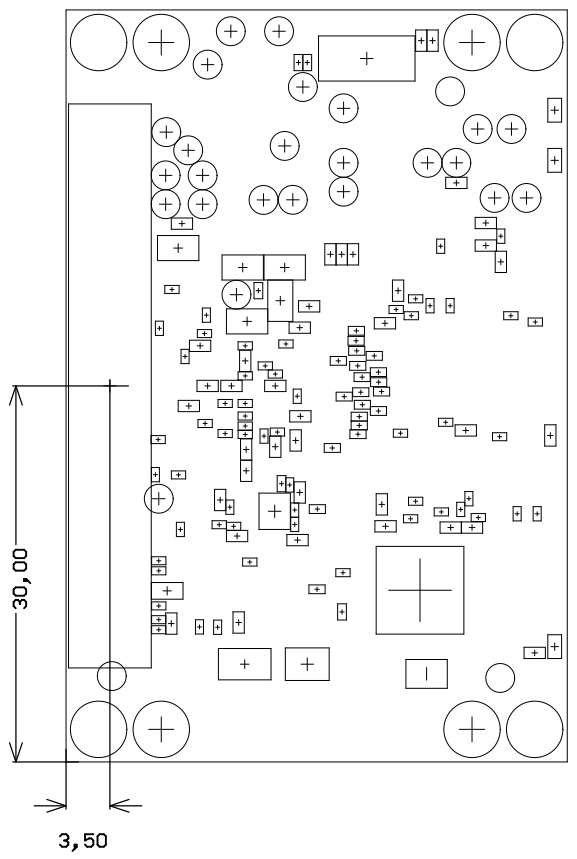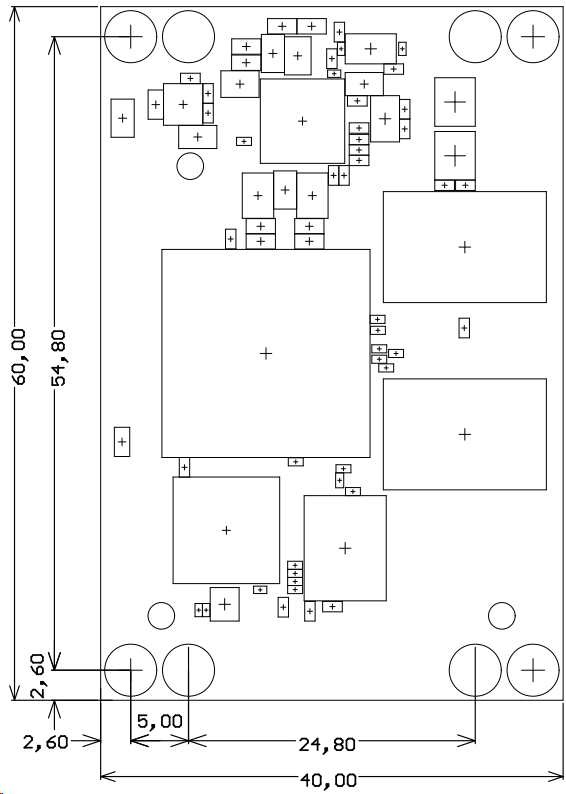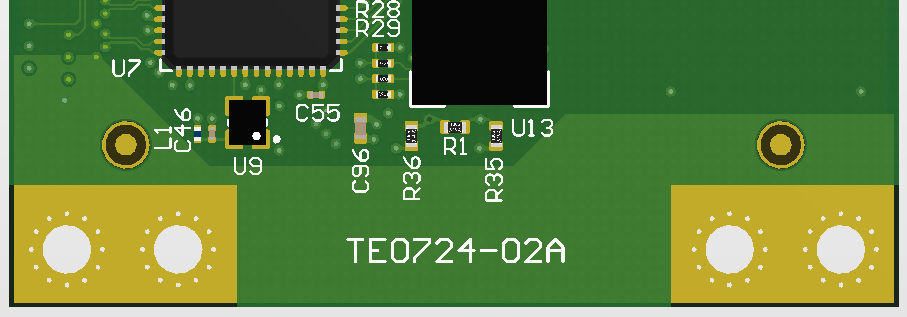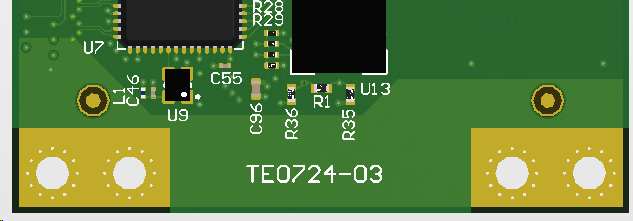Table of Contents
Overview
The Trenz Electronic TE0724 is an industrial-grade SoC module based on Xilinx Zynq 7010/7020, which provides a dual core ARM Cortex A9 and a 7-series FPGA logic. It provides a gigabit ethernet transceiver, 1 GByte of DDR3L SDRAM, 64 MByte Flash memory as configration and data storage. It includes strong power regulators for all needed voltages and a robust high-speed connector for in- and outputs. It has a 6 x 4 cm form factor.
Key Features
- Xilinx Zynq XC7Z010-1CLG400I or XC7Z020-1CLG400I
- Dual-core ARM Cortex-A9 MPCore
- Max. 667 MHz
- Shock proof and vibration resistant
- Size 6 x 4 cm
- Plug-On-Modul with 1 × 160 Pin High-Speed connector
- 1 GByte DDR3L SDRAM
- 64 MByte QSPI Flash Speicher
- 1 x GBit Ethernet PHY
- 1 x MAC-Address EEPROM
- 128 KBit EEPROM
- 1 x CAN Transceiver
- On-Board DC/DC-regulators
- Excellent signal integrity due to evenly-spread supply pins
Additional assembly options are available for cost or performance optimization upon request.
Block Diagramm
Main Components
- XILINX ZYNQ XC7Z020-2CLG400C, U1
- Gigabit Ethernet Transceiver Alaska 88E1512, U7
- Power Manager Dialog DA9062, U4
- 1GByte - 2x 4Gbit DDR3L RAM, U3, U5
- 64MByte ISSI SPI Flash IS25LP512M, U13
- 128KByte Serial EEPROM Microchip 24AA, U10
- CAN Transceiver MCP2542FDT, U2
- 160 Pin Samtec B2B Connector ST5-80-1.50-L-D-P-TR, J1
Initial Delivery State
Storage device name | Content | Notes |
|---|---|---|
| ISSI SPI Flash IS25LP512M, U13 | Empty | |
| DA9062, U4 | Programmed | |
| Microchip 24AA128T, U10 | Empty | USER EEPROM |
| Microchip 24AA025E48T, U23 | MAC write protected preprogrammed, User area empty | EEPROM for MAC-Address. |
Table 1: Initial delivery state of programmable devices on the module.
Boot Process
Boot mode is selected via two Mode pins at B2B connector J2. By default the TE0724 supports JTAG and SPI Boot Mode. Connecting a SD Card via B2B connector to MIO Pins (See SD Card Interface) gives the possibility to boot from SD Card. The Mode pins are pulled up at the module.
Boot mode | MODE1 J1-2 | MODE0 J1-4 |
|---|---|---|
| JTAG (cascade) | LOW | LOW |
| invalid | LOW | HIGH |
| SPI | HIGH | LOW |
| SD CARD (not on module) | HIGH | HIGH |
Table 2: Boot mode selection.
Signals, Interfaces and Pins
Board to Board (B2B) I/Os
I/O signals connected to the SoCs I/O bank and B2B connector:
| Bank | Type | B2B Connector | I/O Signal Count | Bank Voltage | Notes |
|---|---|---|---|---|---|
| 500 | MIO | J1 | 8 I/Os | 3.3V | On-module power supply. |
| 501 | MIO | J1 | 12 I/Os | 1.8V | On-module power supply. |
| 34 | HR | J1 | 32 I/Os or 16 LVDS pairs | 3.3V | On-module power supply. |
| 35 | HR | J1 | 48 I/Os or 24 LVDS pairs | VCCIO_35 | Supplied by the carrier board. |
Table 3: General overview of PL I/O signals connected to the B2B connectors.
All PS MIO banks as well as PL bank 34 are powered by on-module DC-DC power rails. Valid VCCO_35 for PL bank 35 should be supplied via the B2B connector.
For detailed information about the pin out, please refer to the Pin-out Tables.
The configuration of the PS I/Os MIO40 to MIO51 depend on the carrier board peripherals connected to these pins.
JTAG Interface
JTAG access to the ZYNQ SoC is provided through B2B connector J1 and testpoints.
JTAG Signal | B2B Connector Pin |
|---|---|
| TCK | J1-147 |
| TDI | J1-151 |
| TDO | J1-145 |
| TMS | J1-149 |
Table 4: JTAG interface signals.
System Controller Pins
Special purpose pins are available for System Controller functions and are routed to the Power Management IC (U4) with the following default configuration:
| Signal Name | Mode | Function | B2B Connector Pin | Configuration |
|---|---|---|---|---|
| RESETREQ | INPUT | Reset request | J1-150 | Aktive LOW, enter reset mode when set low. Pulled up to VIN. |
| ONKEY | INPUT | Power-on key | J1-148 | Debounced edge sensitve power mode manipulator. On/Off with optional long press shutdown, function dependent on register value of NONKEY_PIN, KEY_DELAY. |
| PWR_TP | IN/OUT | Test pin | J1-146 | Enables Power Commander boot mode and supply pin for OTP fusing voltage. |
| PWR_GPIO2 | IN/OUT | J1-143 | ||
| PWR_GPIO2 | IN/OUT | J1-141 |
Table 5: System Controller CPLD I/O pins.
Quad SPI Interface
Quad SPI Flash (U13) is connected to the Zynq PS QSPI_0 interface via PS MIO bank 500, pins MIO1 ... MIO6.
| MIO | Signal Name | U14 Pin |
|---|---|---|
| 1 | SPI_CS | C2 |
| 2 | SPI_DQ0/MIO2 | D3 |
| 3 | SPI_DQ1/MIO3 | D2 |
| 4 | SPI_DQ2/MIO4 | C4 |
| 5 | SPI_DQ3/MIO5 | D4 |
| 6 | SPI_SCK/MIO6 | B2 |
Table 6: Quad SPI interface signals and connections.
SD Card Interface
There is no physical SD Card slot on the module. Three different interface options are possible at a carrier via the PS MIO 10 to 15 or 40 to 45 or 46 to 51 plus additional MIOs for SD Card Detect and Write Protect as well as SD Card Power Controls. For details compare Xilinx UG585-Zynq-7000-TRM Table 2-4.
Ethernet Interface PHY
The TE0724 is equipped with a Marvell Alaska 88E1512 Gigabit Ethernet PHY (U7) connected to PS Ethernet GEM0. The I/O Voltage is fixed at 1.8V for HSTL signaling. The reference clock input of the PHY is supplied from an on-board 25.000000 MHz oscillator (U9), the 125MHz output clock signal CLK_125MHZ is connected to the PL IO_L11P_T1_SRCC_34.
| PHY Pin | PS bank 501 | B2B | Notes |
|---|---|---|---|
| MDC/MDIO | MIO52/MIO53 | - | |
| LED0 | - | J1-10 | |
| LED1 | - | J1-12 | |
| LED2/Interrupt | - | - | not connected |
| CONFIG | - | - | connected to 1.8V (VDDO), PHY Address = 1 |
| RESETn | MIO39 | - | |
| RGMII | MIO16..MIO27 | - | |
| SGMII | - | - | not connected |
| MDI | - | J1-7,9,13,15,19,21,25,27 |
Table 7: Ethernet PHY connections.
CAN PHY
A felxible data rate CAN Transceiver is provided by a Microchip MCP2542FDT.
| PHY Pin | PL bank 34 | B2B | Notes |
|---|---|---|---|
| TX/RX | IO_L1P/IO_L1N | - | |
| CAN_L / CAN_H | - | J1-1 / J1-3 |
Table 8: CAN PHY connections.
I2C Interface
On-board I2C devices are connected to PS MIO28 (SCL) and MIO29 (SDA). I2C addresses for on-board devices are listed in the table below:
| I2C Device | 7bit I2C Address | Notes |
|---|---|---|
| MAC EEPROM, U23 | 0x53 | 1.8V |
| USER EEPROM, U10 | 0x50 | 1.8V |
| Power Management U4 | 0x58 / 0x59 | 3.3V |
| J1 | - | J1-142 SDA, J1-144 SDL at 3.3V |
Table 9: I2C slave device addresses.
On-board Peripherals
Power Management IC
The power management IC (U4) is provided by dialog Semiconductors (DA9062). It controls the power-on sequencing of the various power rails. It is preprogrammed and accessible via I2C address 0x58 / 0x59. For a detailed description of the configurable power management IC please refer to the datasheet of dialog semicondutor DA9062.
DDR Memory
By default TE0724 module has 2 DDR3L SDRAM chips arranged into 32-bit wide memory bus providing total of 1 GBytes of on-board RAM. Different memory sizes are available optionally.
Quad SPI Flash Memory
On-board QSPI flash memory (U13) on the TE0724-04 is a ISSI IS25LP512M with 512 Mbit (64 MByte) storage capacity. This non volatile memory is used to store initial FPGA configuration. Besides FPGA configuration, remaining free flash memory can be used for user application and data storage. All four SPI data lines are connected to the FPGA allowing x1, x2 or x4 data bus widths. Maximum data rate depends on the selected bus width and clock frequency used.
SPI Flash QE (Quad Enable) bit must be set to high or FPGA is unable to load its configuration from flash during power-on. By default this bit is set to high at the manufacturing plant.
MAC Address EEPROM
A Microchip 24AA025E48 serial EEPROM (U23) contains a globally unique 48-bit node address, which is compatible with EUI-48(TM) specification. The device is organized as two blocks of 128 x 8-bit memory. One of the blocks stores the 48-bit node address and is write protected, the other block is available for application use. It is accessible over I2C bus with slave device address 0x53.
Max. I2C Speed for 24AA025E48 EEPROM is 100kHz.
USER EEPROM
A Microchip 24AA128T serial EEPROM (U10) is available for e.g. module identification and user Data. The device has 128Kbit memory with max 64 bytes page write capability. It is accessible over I2C bus with slave device address 0x50.
Max. I2C Speed for 24AA128T EEPROM is 100kHz.
Oscillators
The module has following reference clock signals provided by on-board oscillators and external source from carrier board:
| Clock Source | Schematic Signal | Frequency | Clock Destination |
|---|---|---|---|
| SiTime SiT8008BI oscillator, U9 | ETH_XTAL | 25.000000 MHz | XTAL_IN, U7 ETH PHY |
| SiTime SiT8008AI oscillator, U6 | PS_CLK | 33.333333 MHz | PS_CLK_500, Bank 500 |
Table10 : Reference clock signals.
On-board LEDs
| LED | Color | Connected to | Description and Notes |
|---|---|---|---|
| D1 | Green | PS MIO7 | User LED. |
| D2 | Green | PL IO_L3P_T0_34 | User LED. |
| D3 | Red | PL IO_L4N_T0_34 | User LED. |
Table 11: On-board LEDs.
Pin Header
Optional assembled Pin Header J2 can be used for PMIC In-System Programming.
Pin | Signal | B2B |
|---|---|---|
| J2-1 | VIN | J1-154, J1-156, J1-158, J1-160 |
| J2-2 | GND | |
J2-3 | I2C_SCL | J1-142 |
| J2-4 | I2C_SDA | J1-144 |
| J2-5 | ONKEY | J1-148 |
| J2-6 | PWR_TP | J1-146 |
Table 12: Optional assembled Pin Header.
Power and Power-On Sequence
Power Consumption
The maximum power consumption of a module mainly depends on the design running on the FPGA.
Xilinx provide a power estimator excel sheets to calculate power consumption. It's also possible to evaluate the power consumption of the developed design with Vivado. See also Trenz Electronic Wiki FAQ.
| Power Input | Typical Current |
|---|---|
| VIN | TBD* |
Table 13: Typical power consumption.
* TBD - To Be Determined soon with reference design setup.
Power supply with minimum current capability of ...A for system startup is recommended.
The on-board voltages of the TE0724 SoC module will be powered-up in order of a determined sequence after the external voltages VIN is available and nONKEY is asserted.
Power Distribution Dependencies
DCDC U8 component is either TPS82140 (2 A) or MUN12A (3 A) depending on the variant.
See Xilinx data sheet for additional information. User should also check related base board documentation when intending base board design for TE0724 module.
Power-On Sequence
The TE0724 SoM meets the recommended criteria to power up the Xilinx Zynq MPSoC properly by keeping a specific sequence of enabling the on-board DC-DC converters dedicated to the particular functional units of the Zynq chip and powering up the on-board voltages. For a detailed description of the configurable Power Management IC please refer to the datasheet of dialog semicondutor DA9062.
Following diagram clarifies the sequence of enabling the particular on-board voltages, which will power-up in ascending order as listed in the blocks of the diagram:
Power Rails
Power Rail Name | B2B JM1 Pins | Direction | Notes |
|---|---|---|---|
| VIN | 154, 156, 158,160 | Input | Main supply voltage from the carrier board. |
| VCCIO_35 | 54 | Input | PL Bank 35 supply voltage. |
| VLDO1 | 83 | Output | 3.3V (100mA) |
| VLDO2 | 94 | Output | 1.8V (300mA) |
| VLDO34 | 53 | Output | 2.5V (600mA) |
| 3.3V | 43, 74 | Output | Additional module on-board 3.3V voltage supply (2 A or 3 A variant dependent). |
| 1.0V | - | Buck1 & Buck2 of U4. | |
| 1.8V | 63 | Output | Buck3 of U4. |
| VDD_DDR | - | DDR supply voltage powered by Buck4 of U4. | |
VBAT | 152 | Output/Input | Battery charger (out) and supply for RTC and 32kHz crystal (in). |
Table 14: Module power rails.
Current rating of the Samtec connector is 1.6A per pin (1 pin powered per row).
Bank Voltages
Bank | Schematic Name | Voltage | Voltage Range |
|---|---|---|---|
| 500 MIO | 3.3V | 3.3V | - |
| 501 MIO | 1.8V | 1.8V | - |
| 502 DDR3 | VDD_DDRV | 1.35V | - |
| 34 HR | 3.3V | 3.3V | - |
| 35 HR | VCCIO_35 | User | 1.2V to 3.3V |
Table 15: Module PL I/O bank voltages.
Board to Board Connectors
Order | REF Number | Samtec Number | Type | Mated Height | Data sheet | Comment |
|---|---|---|---|---|---|---|
| 27220 | REF-192552-02 | ST5-80-1.50-L-D-P-TR | Module connector | 5 mm | http://suddendocs.samtec.com/catalog_english/st5.pdf | Standard connector used on module |
| 27219 | REF-192552-01 | SS5-80-3.50-L-D-K-TR | Baseboard connector | 5 mm | http://suddendocs.samtec.com/catalog_english/ss5.pdf | Standard connector used on board |
With different connectors from the used series other mating heights are possible (according to the Datasheet). The module and base board can be manufactured using other connectors upon request.
| Connector Specifications | Value |
|---|---|
| Insulator material | Liquid crystal polymer |
| Stacking height | 5 mm |
| Contact material | Phosphor-bronze |
| Plating | Au or Sn over 50 μ" (1.27 μm) Ni |
| Current rating | 1.6 A per pin (2 pins powered) |
| Operating temperature range | -55 °C to +125 °C |
| RoHS compliant | Yes |
Connector Speed Ratings
The LSHM connector speed rating depends on the stacking height; please see the following table:
| Stacking height | Speed rating |
|---|---|
| 5 mm, Single-Ended | 13.5GHz / 27Gbps |
| 5 mm, Differential | 20GHz / 40Gbps |
| 4 mm, Single-Ended | 13GHz / 26Gbps |
| 4 mm, Differential | 13.5GHz / 27Gbps |
Current Rating
Current rating of Samtec Razor Beam™ SS5/ST5 B2B connectors is 1.6A per pin (2 pins powered).
Connector Mechanical Ratings
- Shock: 100G, 6 ms sawtooth wave
- Vibration: 7.56G 'RMS', 2 hours per axis, 3 axes total
Manufacturer Documentation
Variants Currently In Production
| Trenz shop TE0724 overview page | |
|---|---|
| English page | German page |
Technical Specifications
Absolute Maximum Ratings
Parameter | Min | Max | Units | Reference Document |
|---|---|---|---|---|
VIN supply voltage | -0.3 | 5.5 | V | da9062_3v4.pdf |
Storage temperature | -40 | 85 | °C | - |
Table 18: Module absolute maximum ratings.
Recommended Operating Conditions
| Parameter | Min | Max | Units | Reference Document |
|---|---|---|---|---|
| VIN supply voltage (variant "-Z" with MUN12A for U8) | 4.5 | 5.5 | V | |
| VIN supply voltage (all other variants) | 3.6 | 5.5 | V | |
| Operating temperature | -40 | 85 | °C |
Table 19: Module recommended operating conditions.
Operating Temperature Ranges
Commercial grade: 0°C to +70°C.
Extended grade: 0°C to +85°C.
Industrial grade: -40°C to +85°C.
Module operating temperature range depends also on customer design and cooling solution. Please contact us for options.
Physical Dimensions
Module size: 60 mm × 40 mm. Please download the assembly diagram for exact numbers.
Mating height with standard connectors: 5.0 mm.
PCB thickness: 1.6 mm.
Highest part on PCB: approx. 1.6 mm. Please download the step model for exact numbers.
All dimensions are given in millimeters.
Revision History
Hardware Revision History
| Date | Revision | Notes |
|---|---|---|
| 2020-11-05 | 04 | Changed DDR3, Flash, see PCN |
| 2019-03-12 | 03 | changed 3.3V DCDC |
| 02A | Electrical same as REV 02. | |
| 02 | First production release | |
| - | 01 | Prototypes |
Table 20: Module hardware revision history.
Hardware revision number can be found on the PCB board together with the module model number separated by the dash.
Document Change History
Date | Revision | Contributors | Description |
|---|---|---|---|
| |||
| 2020-11-17 | v.58 | Martin Rohrmüller |
|
| 2019-10-31 | v.56 | Martin Rohrmüller |
|
| 2019-10-30 | v.55 | John Hartfield |
|
2019-06-27 | v.54 | Martin Rohrmüller |
|
2019-06-11 | v.53 | Guillermo Herrera |
|
2019-03-29 | v.51 | Martin Rohrmüller |
|
2018-11-20 | v.44 | John Hartfiel |
|
2018-10-10 | v.43 | John Hartfiel |
|
2018-10-09 | v.42 | Martin Rohrmüller |
|
2018-10-01 | v.41 | Martin Rohrmüller |
|
2018-09-21 | v.39 | Martin Rohrmüller |
|
2018-07-20 | v.37 | John Hartfield |
|
2018-07-06 | v.34 | Martin Rohrmüller |
|
| --- | all |
|
Table 21: Document change history.
Disclaimer
Data Privacy
Please also note our data protection declaration at https://www.trenz-electronic.de/en/Data-protection-Privacy
Document Warranty
The material contained in this document is provided “as is” and is subject to being changed at any time without notice. Trenz Electronic does not warrant the accuracy and completeness of the materials in this document. Further, to the maximum extent permitted by applicable law, Trenz Electronic disclaims all warranties, either express or implied, with regard to this document and any information contained herein, including but not limited to the implied warranties of merchantability, fitness for a particular purpose or non infringement of intellectual property. Trenz Electronic shall not be liable for errors or for incidental or consequential damages in connection with the furnishing, use, or performance of this document or of any information contained herein.
Limitation of Liability
In no event will Trenz Electronic, its suppliers, or other third parties mentioned in this document be liable for any damages whatsoever (including, without limitation, those resulting from lost profits, lost data or business interruption) arising out of the use, inability to use, or the results of use of this document, any documents linked to this document, or the materials or information contained at any or all such documents. If your use of the materials or information from this document results in the need for servicing, repair or correction of equipment or data, you assume all costs thereof.
Copyright Notice
No part of this manual may be reproduced in any form or by any means (including electronic storage and retrieval or translation into a foreign language) without prior agreement and written consent from Trenz Electronic.
Technology Licenses
The hardware / firmware / software described in this document are furnished under a license and may be used /modified / copied only in accordance with the terms of such license.
Environmental Protection
To confront directly with the responsibility toward the environment, the global community and eventually also oneself. Such a resolution should be integral part not only of everybody's life. Also enterprises shall be conscious of their social responsibility and contribute to the preservation of our common living space. That is why Trenz Electronic invests in the protection of our Environment.
REACH, RoHS and WEEE
REACH
Trenz Electronic is a manufacturer and a distributor of electronic products. It is therefore a so called downstream user in the sense of REACH. The products we supply to you are solely non-chemical products (goods). Moreover and under normal and reasonably foreseeable circumstances of application, the goods supplied to you shall not release any substance. For that, Trenz Electronic is obliged to neither register nor to provide safety data sheet. According to present knowledge and to best of our knowledge, no SVHC (Substances of Very High Concern) on the Candidate List are contained in our products. Furthermore, we will immediately and unsolicited inform our customers in compliance with REACH - Article 33 if any substance present in our goods (above a concentration of 0,1 % weight by weight) will be classified as SVHC by the European Chemicals Agency (ECHA).
RoHS
Trenz Electronic GmbH herewith declares that all its products are developed, manufactured and distributed RoHS compliant.
WEEE
Information for users within the European Union in accordance with Directive 2002/96/EC of the European Parliament and of the Council of 27 January 2003 on waste electrical and electronic equipment (WEEE).
Users of electrical and electronic equipment in private households are required not to dispose of waste electrical and electronic equipment as unsorted municipal waste and to collect such waste electrical and electronic equipment separately. By the 13 August 2005, Member States shall have ensured that systems are set up allowing final holders and distributors to return waste electrical and electronic equipment at least free of charge. Member States shall ensure the availability and accessibility of the necessary collection facilities. Separate collection is the precondition to ensure specific treatment and recycling of waste electrical and electronic equipment and is necessary to achieve the chosen level of protection of human health and the environment in the European Union. Consumers have to actively contribute to the success of such collection and the return of waste electrical and electronic equipment. Presence of hazardous substances in electrical and electronic equipment results in potential effects on the environment and human health. The symbol consisting of the crossed-out wheeled bin indicates separate collection for waste electrical and electronic equipment.
Trenz Electronic is registered under WEEE-Reg.-Nr. DE97922676.



